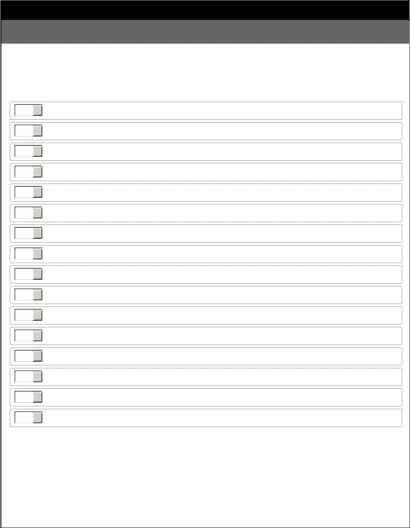EMerging Issues for Private Wells - CSTE Assessment
Information Collections to Advance State, Tribal, Local and Territorial (STLT) Governmental Agency System Performance, Capacity, and Program Delivery
Att B_Instrument_Web version
Emerging Issues for Private Wells - CSTE Assessment
OMB: 0920-0879
 CSTE
Membership
Assessment
Emerging
Issues
for
Private
Wells
CSTE
Membership
Assessment
Emerging
Issues
for
Private
Wells
Form Approved
OMB No. 09200879
Expiration Date 04/30/2017
This assessment is directed to members of the Council of State and Territorial Epidemiologists (CSTE) or their delegates who have responsibility for private residential wells and public health. This project is funded through a Cooperative Agreement with the Centers for Disease Control and Prevention.
This assessment was developed to identify emerging public health issues facing private residential well owners, gaps in private well knowledge or stewardship practices, tools and resources needed to address these gaps, and any anticipated changes in policies or legislation impacting private residential wells and private residential well users.
The anticipated respondent is the person within your state health department or in your state environment department, who knows the most about private residential wells and works with private residential well owners. Please forward this assessment to that person. We also encourage you to involve other potential stakeholders/partners (National Ground Water Association, Water Systems Council, etc.) when answering these questions, as they work closely with private residential well owners.
The information obtained from this assessment will provide data needed to inform future activities conducted by 1) the Health Studies Branch, Division of Environmental Hazards and Health Effects, National Center for Environmental Health, Centers for Disease Control and Prevention; 2) CSTE Private Wells Workgroup; and 3) other public health partners to address private wellrelated public health issues. Identifiable information about the respondent (name, position, agency, phone, and email) will be removed when the results of this assessment are aggregated for analysis. Individually identifiable state responses will be kept secured and will not be shared with the Workgroup or any other entity without permission.
This assessment is estimated to require an average of 60 minutes of your time.
Thank you for completing this assessment by MONTH DAY, 2015. Please contact Jennifer Lemmings
([email protected] or 7704583811) if you have any questions. We appreciate your time and attention to this matter. Follow the directions accompanying each question.
**Public reporting burden of this collection of information is estimated to average 60 minutes per response, including time for reviewing instructions, searching existing data sources, gathering and maintaining the data needed, and completing and reviewing information. An agency may not conduct or sponsor, and a person is not required to respond to a collection of information unless it displays a currently valid Office of Management and Budget control number. Send comments regarding this burden estimate, or any other aspect of this information collection, including suggestions for reducing this burden to CDC/Agency for Toxic Substance and Disease Registry Information Collection Review Office,
1600 Clifton Road NE, MS D74, Atlanta, Georgia 30333; Attention: PRA (09200879). **
*1. Please enter the following information about the primary respondent to this assessment
Name:
Position:
Agency:
State/Province:
Email Address:
Phone Number:
CSTE Membership Assessment Emerging Issues for Private Wells
2. What types of private well programs exist in your state and what aspects of private well
stewardship does each program address? In the text boxes below, please write the name of the program followed by a 1 line description of the stewardship it addresses. (e.g., Private Well Testing Funds well water quality testing; Newsletter private well water maintenance)
Program Stewardship
Program Stewardship
Program Stewardship
Program Stewardship
Program Stewardship
Program Stewardship
Program Stewardship
Program Stewardship
Program Stewardship
Program Stewardship
3. Is your State Health Department involved in designing and implementing these private
well programs?
mlj
Yes, all of them
mlj
Yes, some of them
mlj
No, another group is responsible for these programs
mlj
Unsure
 mlj
mlj
Other (please specify)
CSTE Membership Assessment Emerging Issues for Private Wells
4. Does the state provide guidance regarding treatment options for private well water?
mlj
Yes
mlj No
mlj
Unsure
mlj
Other (please specify)
5

6
 CSTE
Membership
Assessment
Emerging
Issues
for
Private
Wells
CSTE
Membership
Assessment
Emerging
Issues
for
Private
Wells
*5. What (other) programs, if any, are in place for private wells in your state?
5
6
CSTE Membership Assessment Emerging Issues for Private Wells
6. Select the top three (3) contaminants of concern you think have a substantial public
health impact due to exposure to private well water within your state. Select only three (3)
options below
fec
Arsenic
fec
Cadmium
fec
Chemicals (e.g., runoff, industrial discharge)
fec
Chromium
fec
Chloride
fec
Copper
fec
Fluoride
fec
Hardness
fec
Iron
fec
Lead
fec
Manganese
fec
MBTE and other gasoline additives
fec
Nitrates
fec
Pathogens including bacteria, viruses and/or protozoa
fec
Pesticides
fec pH
fec
Radium
fec
Radon
fec
Selenium
fec
Sulfate
fec
Total dissolved solids
fec
Uranium
fec
Volatile Organic Compounds (VOCs)
fec
Other

Other (please specify)
CSTE Membership Assessment Emerging Issues for Private Wells
Questions 718 are about the most pressing concerns currently within your state regarding private well water for drinking water. Each of the questions regards a subcategory within the larger topic of drinking water.
7. Please select the most pressing concerns about private well water for drinking water within your state related to water quality. Select all that apply.
fec
Water quality
fec
a. Agricultural practices
fec
b. Biological
fec
c. Chemical
fec
d. Testing
fec
e. Regulations
fec
f. Source
fec
Not Applicable
Other (please specify)
5
6
8. Please select the most pressing concerns about private well water for drinking water
within your state related to water quantity. Select all that apply.
fec
Water quantity
fec
a. Agricultural practices
fec
c. Depleting water source
fec
d. Regulations
fec
Not applicable

Other (please specify)
5
6
CSTE Membership Assessment Emerging Issues for Private Wells
9. Please select the most pressing concerns about private well water for drinking water within your state related to climate change. Select all that apply.
fec
Climate change
fec
a. Water quantity due to periods of long periods of drought
fec
b. Changing weather patterns, more/less frequent periods of drought/flooding
fec
c. Devastation from natural disasters
fec
Not applicable
Other (please specify)
5
6
10. Please select the most pressing concerns about private well water for drinking water
within your state related to industrial activities. Select all that apply.
fec
Industrial activities
fec
a. Mineral extraction
fec
b. Superfund Sites
fec
c. Emerging chemicals
fec
d. Persistent chemicals
fec
Not applicable

Other (please specify)
5
6
CSTE Membership Assessment Emerging Issues for Private Wells
11. Please select the most pressing concerns about private well water for drinking water within your state related to staffing. Select all that apply.
fec
Staffing
fec
a. Not enough agencies working on private wells
fec
b. Not enough staff to support private well testing demand
fec
c. Not enough staff to analyze private well testing data
fec
d. Not enough training/education of staff
fec
e. Coordination
fec
Not applicable
Other (please specify)
5
6
12. Please select the most pressing concerns about private well water for drinking water
within your state related to development. Select all that apply.
fec
Development
fec
a. Urban sprawl
fec
b. New development of rural areas
fec
c. Land preservation
fec
d. Supporting population growth
fec
Not applicable

Other (please specify)
5
6
CSTE Membership Assessment Emerging Issues for Private Wells
13. Please select the most pressing concerns about private well water for drinking water within your state related to infrastructure. Select all that apply.
fec
Infrastructure
fec
a. Appropriately locating new or replacement wells
fec
b. Older private well infrastructure
fec
c. Infrastructure in place to protect groundwater
fec
Not applicable
Other (please specify)
5
6
14. Please select the most pressing concerns about private well water for drinking water
within your state related to regulations/legislation. Select all that apply.
fec
Regulations/Legislation
fec
a. Local ordinances regarding private well testing
fec
b. State regulations
fec
Not applicable
Other (please specify)
5
6
15. Please select the most pressing concerns about private well water for drinking water
within your state related to availability of testing. Select all that apply.
fec
Availability of testing
fec
a. Testing methods
fec
b. Limited access to a laboratory
fec
c. Limited funds for testing
fec
d. Limited availability of test kits that can be used by homeowners
fec
Not applicable

Other (please specify)
5
6
CSTE Membership Assessment Emerging Issues for Private Wells
16. Please select the most pressing concerns about private well water for drinking water within your state related to funding for testing. Select all that apply.
fec
Funding for testing
fec
a. At the state and local levels
fec
b. Private residential testing
fec
c. Access to home testing kits
fec
Not applicable
Other (please specify)
5
6
17. Please select the most pressing concerns about private well water for drinking water
within your state related to public education. Select all that apply.
fec
Public education
fec
a. Public knowledge of contaminants
fec
b. Public knowledge of water sources
fec
c. Public knowledge of quality/waterborne illnesses
fec
d. Resources for public education
fec
Not applicable

Other (please specify)
5
6
CSTE Membership Assessment Emerging Issues for Private Wells
18. Please select the most pressing concerns about private well water for drinking water within your state related to location of wells. Select all that apply.
fec
Location of wells
fec
a. Data regarding location information
fec
b. Finding/ adding new wells
fec
c. Locating old wells
fec
d. Real estate information regarding well quality
fec
Not applicable

Other (please specify)
5
6
 CSTE
Membership
Assessment
Emerging
Issues
for
Private
Wells
CSTE
Membership
Assessment
Emerging
Issues
for
Private
Wells
Questions 1927 are about emerging issues within your state regarding private well water used for drinking water.
19. Rank the emerging private well water issues that you anticipate your state will have to address in the next 10 to 20 years
6 Agriculture practices
6 Appropriately locating new or replacement wells
6 Availability of testing (including testing methods or access to a laboratory)
6 Certification of oversight of the private well water treatment industry
6 Changes in water quality (e.g., agricultural practices, biological, chemical, testing, regulations, source)
6 Changes in water quantity
6 Climate change
6 Changes in water source
6 Energy development
6 Funding for testing
6 Increase in water demand
6 Industrial activity
6 Old private well infrastructure
6 Increased pressure from legislatures to revise or add regulations
6 Urban sprawl
6 Other
CSTE Membership Assessment Emerging Issues for Private Wells
20. Indicate why your most important concern (indicated as #1 in Question 19) is of importance in your state. Select all options below that apply.
fec
Costs the most to address
fec
Costs the least to address
fec
Affects the most people or represents a barrier to improved public health for the largest number of people
fec
Poses the greatest overall health risk
fec
Disproportionately affects a vulnerable population
fec
Other
Other (specify)
21. Indicate why your second most important concern (indicated as #2 in Question 19) is of
importance in your state. Select all options below that apply.
fec
Costs the most to address
fec
Costs the least to address
fec
Affects the most people or represents a barrier to improved public health for the largest number of people
fec
Poses the greatest overall health risk
fec
Disproportionately affects a vulnerable population
fec
Other
Other (specify)
22. Indicate why your third most important concern (indicated as #3 in Question 19) is of
importance in your state. Select all options below that apply.
fec
Costs the most to address
fec
Costs the least to address
fec
Affects the most people or represents a barrier to improved public health for the largest number of people
fec
Poses the greatest overall health risk
fec
Disproportionately affects a vulnerable population
fec
Other

Other (specify)
CSTE Membership Assessment Emerging Issues for Private Wells
23. What are your recommendations for how to address the emerging issues you selected
in Question 19?
5
6
*24. Do you currently have the resources to support your recommendations for plans to address these emerging private well water issues as answered in Question 19?
mlj
Yes

mlj No
Please explain either your Yes or No answer
5
6
 CSTE
Membership
Assessment
Emerging
Issues
for
Private
Wells
CSTE
Membership
Assessment
Emerging
Issues
for
Private
Wells
25. What tools (e.g., access to data, geospatial mapping, effective outreach/education
materials, improved tools to provide guidance regarding treatment, etc.) do you need to address the top 3 important concerns you selected in Question 19?
Please rank the tools you need in order of priority with “1” being the most important and
“5” being the least important.
1.
2.
3.
4.
5.
 CSTE
Membership
Assessment
Emerging
Issues
for
Private
Wells
CSTE
Membership
Assessment
Emerging
Issues
for
Private
Wells
26. Indicate your top three (3) types of information you anticipate will be most needed by
people in your state due to these emerging private well water issues. Rank only 3 options below.
Importance Level
Known common sources of well water contamination 6
Potential health effects from using contaminated well water for drinking and food 6
preparation
Relative level of risk associated with various concentrations of contaminants 6
Factors that make a private well susceptible to contamination 6
Testing guidance and requirements 6
List of certified testing laboratories 6
Funds to pay for testing 6
Understanding test results 6
How to correct contamination problems (including how to choose from among 6
treatment options)
Preventing well contamination problems 6
Information on how to choose a well constructor/driller (i.e., what questions to ask your 6
well constructor/driller)
Other 6
Other (please specify)
27. Provide any additional comments you may have here regarding any part of the
assessment:
5
6
 CSTE
Membership
Assessment
Emerging
Issues
for
Private
Wells
CSTE
Membership
Assessment
Emerging
Issues
for
Private
Wells
--------------------------------------------------------------------------------
Thank you for your participation
Thank you for taking the time to answer these questions. Your responses are invaluable to our decision making and the planning of future activities.
Page

| File Type | application/vnd.openxmlformats-officedocument.wordprocessingml.document |
| Author | Boey, Angeline (CDC/OSTLTS/DPHPI) |
| File Modified | 0000-00-00 |
| File Created | 2021-01-26 |
© 2025 OMB.report | Privacy Policy